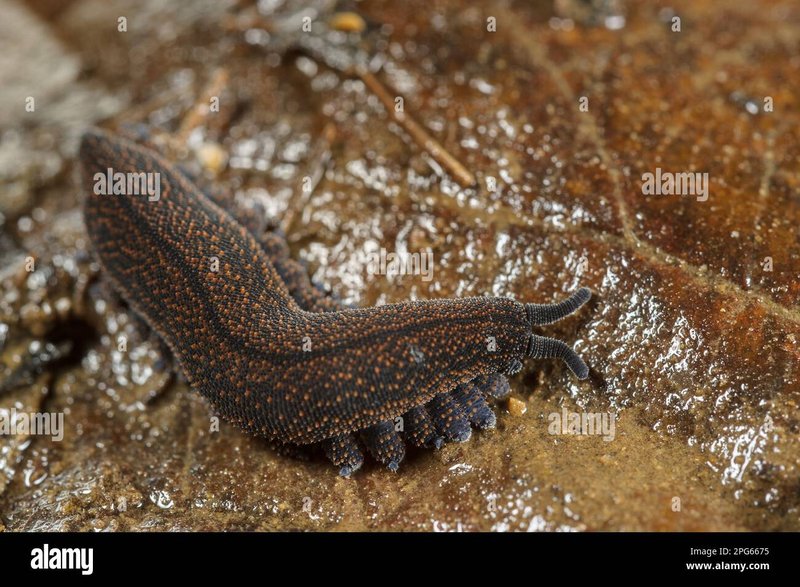
You might be wondering why velvet worms, known scientifically as *Onychophora*, are important. They help break down leaf litter, recycling organic matter and supporting the entire ecosystem around them. They’re kind of the unsung heroes of the forest floor. In this article, we’ll explore their biology, habitat, role in the ecosystem, and why they matter to the broader environmental tapestry.
What Are Velvet Worms?
Velvet worms are unique creatures that often blend the characteristics of both worms and insects. They have elongated bodies, usually measuring around 4 to 10 centimeters long, and are covered in a soft, velvety texture that gives them their name. But here’s the cool part: They have multiple pairs of stubby legs—like little appendages sticking out from their sides—making them look like a quirky mix of a caterpillar and an insect.
These fascinating worms are mostly found in humid and tropical environments, tucked away in the leaf litter that carpets the forest floor. They thrive in these damp conditions, helping to maintain moisture levels in their habitats. Because they often stay hidden, many people may not know they exist, but they’re out there, playing a crucial role behind the scenes.
The Role of Velvet Worms in Leaf Litter Ecosystems
So, what exactly do velvet worms do in leaf litter ecosystems? Well, these little guys are nature’s recyclers. Their primary role is to break down decaying organic matter, like fallen leaves, dead insects, and other plant materials. By doing this, they help transform what would otherwise be waste into nutrients that enrich the soil. And guess what? This benefits a whole host of plants and animals.
As they move through the leaf litter, they also create channels in the soil, allowing air and moisture to penetrate deeper into the ground. This process is vital for maintaining healthy soil structure, which supports plant growth. Think of velvet worms as tiny engineers working tirelessly to keep our ecosystems in balance.
Feeding Habits
Velvet worms are carnivorous creatures, having developed some rather interesting feeding techniques. They use their slime to capture prey, which typically consists of small insects and other tiny animals. Imagine a tiny superhero spitting out a sticky web to catch its dinner! This slime can immobilize their prey, allowing velvet worms to feast on it without much effort.
Once the prey is caught, they have a powerful mouth equipped with sharp jaws, ready to devour their meal. Their ability to consume and break down these small creatures means they also play a role in controlling insect populations in their habitats.
Habitat: Where Do They Live?
Velvet worms predominantly inhabit leaf litter in tropical and subtropical forests. They thrive in damp, shaded areas where moisture levels are consistent. You can often find them hiding under fallen leaves, rotting logs, or within the rich organic layer of soil. Their preference for dark, humid environments makes them quite sensitive to changes in their habitat.
However, they are also vulnerable to habitat loss due to deforestation and climate change. As humans encroach on their natural habitats, it’s crucial to understand the importance of preserving the ecosystems that support these unique creatures. Without them, we risk disrupting the delicate balance of life in leaf litter ecosystems.
Temperature and Humidity Requirements
These worms require specific temperature and humidity levels to survive. They thrive in temperatures typically ranging from 16 to 24 degrees Celsius, and they need high humidity, usually over 80%. This is why you won’t find them in dry, arid environments. The moisture helps keep their skin from drying out, as they breathe through their skin—a fascinating adaptation!
Monitoring temperature and humidity levels is crucial in ecosystems where velvet worms are found. Changes in these conditions can directly impact their survival, affecting the health of the leaf litter ecosystem as a whole.
Conservation and Why Velvet Worms Matter
You might be surprised to learn that these intriguing creatures face threats from habitat destruction, pollution, and climate change. As we lose forests and natural habitats, we risk wiping out not just velvet worms but the entire leaf litter ecosystem they help support. This is concerning because they play a critical role in nutrient cycling and maintaining soil health.
Additionally, velvet worms are an indicator species. This means that their presence or absence can offer valuable insights into the health of their environment. If velvet worms are thriving, it’s a sign that the ecosystem is doing well. Conversely, if they begin to decline, it could signal underlying problems within the ecosystem.
What You Can Do
Here’s the thing: we can all play a part in helping conserve these remarkable creatures. Simple actions like supporting reforestation efforts, reducing plastic usage, and advocating for sustainable practices can make a difference. Every little bit helps to protect the habitats that velvet worms—and many other species—call home.
It’s essential to spread awareness about the significance of leaf litter ecosystems. Sharing information, engaging in local conservation efforts, or even just being mindful of our ecological footprint can contribute to a healthier planet for all.
Velvet worms may be small and tucked away in the shadows of the leaf litter, but their role in the ecosystem is anything but insignificant. From breaking down organic matter to enriching the soil, these unique creatures contribute to the health and balance of our environment. By understanding their importance and committing to protect their habitats, we can ensure that velvet worms continue to thrive in their leafy homes.
Next time you walk through a forest and step on a pile of leaves, remember that there’s a whole world of life beneath your feet, including these incredible little worms. Let’s celebrate them as part of the rich tapestry of nature and commit to protecting the delicate ecosystems they help support.

